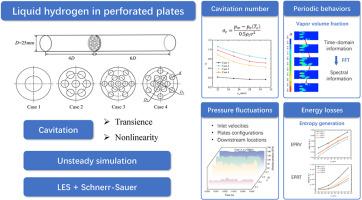液氢在多孔板流量计中的非定常空化特性
IF 8.3
2区 工程技术
Q1 CHEMISTRY, PHYSICAL
引用次数: 0
摘要
随着氢能在各个领域的不断发展和应用,液氢被认为是最有前途的氢储存和运输方法之一。在运输过程中精确的流量测量是至关重要的。然而,当液氢流经节流流量计时,往往会出现空化现象,这可能会影响系统的安全性和稳定性。因此,控制空化,提高测量精度是迫在眉睫的技术挑战。本研究以新近发展的多孔板为研究对象,结合大涡模拟模型和Schnerr-Sauer空化模型,对液氢的非定常空化特性进行数值分析。具体来说,它研究了不同的进口速度和穿孔板配置对空化数、气泡脱落频率、压力波动和熵产生的影响。本研究通过分析空化过程的演变、周期行为和能量损失,探讨了多孔板结构对空化强度和流场稳定性的调节作用,并与单孔板进行了比较。结果表明:在较高的空化强度下,聚集效应增强了气泡脱落过程中低频周期性行为的显著性;熵产分析表明,总熵产主要由速度梯度驱动。在多孔板结构中,空化强度最低的7孔板与单孔板相比,空化数增加了140%,总熵产减少了16.7%。此外,随着射孔数量的增加,湍流诱导阻力和通道诱导阻力呈现相反的趋势,空化强度与它们的共同作用密切相关。这些发现不仅为液氢输运系统中穿孔板的设计和优化提供了理论依据,也为控制和预防空化提供了新的见解和策略。本文章由计算机程序翻译,如有差异,请以英文原文为准。

Unsteady cavitation characteristics of liquid hydrogen in perforated plate flowmeters
With the growing development and application of hydrogen energy across various fields, liquid hydrogen is regarded as one of the most promising methods for hydrogen storage and transportation. Accurate flow measurement during transportation is crucial. However, cavitation tends to occur when liquid hydrogen flows through throttling flowmeters, potentially compromising the safety and stability of the system. Therefore, controlling cavitation and improving measurement accuracy are pressing technical challenges. This study focuses on the recently developed perforated plates, combining the Large Eddy Simulation model and the Schnerr-Sauer cavitation model to numerically analyze the unsteady cavitation characteristics of liquid hydrogen. Specifically, it investigates the effects of different inlet velocities and perforated plate configurations on the cavitation number, bubble shedding frequency, pressure fluctuations, and entropy production. By analyzing the evolution of the cavitation process, its periodic behavior, and energy loss, this study explores the regulatory role of perforated plate structures in cavitation intensity and flow field stability, with comparisons made against single-hole plates. The results indicate that at higher cavitation intensity, the aggregation effect enhances the prominence of low-frequency periodic behaviors in the bubble shedding process. Entropy production analysis reveals that the total entropy production is primarily driven by velocity gradients. Regarding perforated plate structures, the 7-hole plate, which exhibits the lowest cavitation intensity, shows a 140 % increase in cavitation number and a 16.7 % reduction in total entropy production compared to the single-hole plate. Furthermore, as the number of perforations increases, turbulence-induced resistance and channel-induced resistance exhibit opposite trends, with cavitation intensity closely linked to their combined effect. These findings not only provide a theoretical basis for the design and optimization of perforated plates in liquid hydrogen transport systems but also offer new insights and strategies for cavitation control and prevention.
求助全文
通过发布文献求助,成功后即可免费获取论文全文。
去求助
来源期刊

International Journal of Hydrogen Energy
工程技术-环境科学
CiteScore
13.50
自引率
25.00%
发文量
3502
审稿时长
60 days
期刊介绍:
The objective of the International Journal of Hydrogen Energy is to facilitate the exchange of new ideas, technological advancements, and research findings in the field of Hydrogen Energy among scientists and engineers worldwide. This journal showcases original research, both analytical and experimental, covering various aspects of Hydrogen Energy. These include production, storage, transmission, utilization, enabling technologies, environmental impact, economic considerations, and global perspectives on hydrogen and its carriers such as NH3, CH4, alcohols, etc.
The utilization aspect encompasses various methods such as thermochemical (combustion), photochemical, electrochemical (fuel cells), and nuclear conversion of hydrogen, hydrogen isotopes, and hydrogen carriers into thermal, mechanical, and electrical energies. The applications of these energies can be found in transportation (including aerospace), industrial, commercial, and residential sectors.
 求助内容:
求助内容: 应助结果提醒方式:
应助结果提醒方式:


